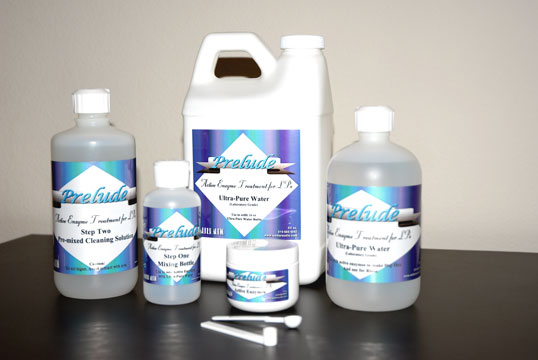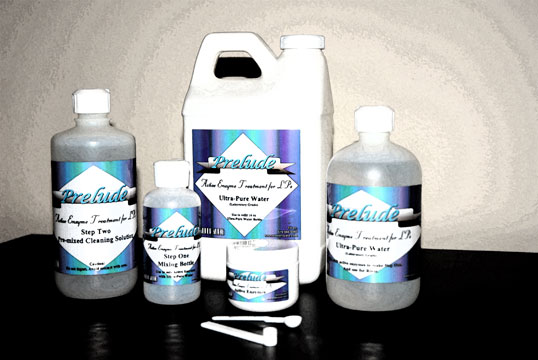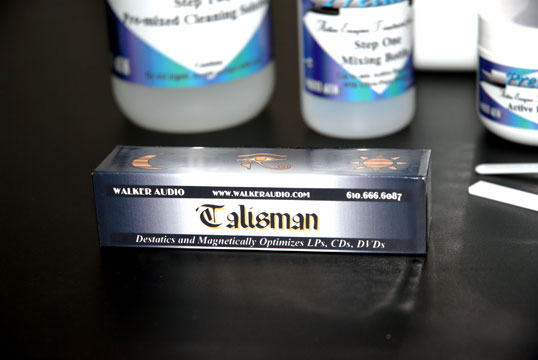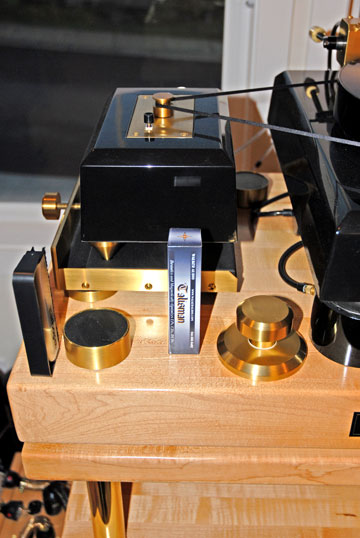You are reading the older HTML site
Positive Feedback ISSUE
may/june 2007
Impressions: More good stuff! Walker Audio Prelude
Record Cleaning System Walker Audio Talisman De-Static/Demagnetizer ("Walker's
Wonderful Wand")
by David W. Robinson
[All photos and image processing by Robinson]
It's happening again: a bad case of "review queue backlog." Time to take care of the problem with some more short takes on the good stuff…

The Walker Audio Prelude Record Cleaning System
First of all—and no surprise—Walker Audio has been at it again. This isn't news; Lloyd and company are always up to something, those clever rascals! The results are usually yet another improvement in one aspect or another of audio reproduction. (Lloyd always measures these progressions with percentage points. I'll get a phone call from him: another 10% here; 5% there; 15% the other place. I've never been able to use percentages to communicate perceived improvements in the sound, but I've never heard Lloyd to be wrong. If he says something is better, I've always seem to end up agreeing with him.)
In this case, we're talking about vinyl. Walker Audio's new Prelude Record Cleaning System is a multi-step procedure based on their experience and experimentation with LP cleaning. This is a subject that Lloyd and company know quite a bit about. Me, I've been trying various record cleaning products since the late '70s. I started with the Discwasher record cleaners way back then (almost totally useless, as it turned out). During the later '80s and early '90s I progressed to the Nitty Gritty cleaner, the LAST cleaners treatments by the estimable Walt Davies and company, then latched on to my trusty-rusty VPI 17F as my cleaning ma-cheen of choice. (Yes, I know that there are other record cleaners out there that may do a better job. According to their specs, some of them are a lot quieter, which is a real weakness in the 17F—it's too loud! Wish I had one of those charmingly discreet new record scrubbers around the place.) A handful of cleaning solutions have been here over the years: VPI, Torumat, Record Research Labs, Disc Doctor. Each one seemed to be more or less an advance over the previous, I'm selfishly glad to say. And now the Prelude had arrived. Would Walker Audio's new product be another step forward, or had I finally hit the point of noticeable diminishing returns for my LPs?
Good question.
How the Prelude procedure works
The Prelude system consists of a small container of powdered active enzymes (the little cleaning nibblers themselves, it appears); a couple of plastic measuring scoops; a 4 ounce mixing bottle for the enzymes; a 16 ounce bottle of "Ultra Pure Laboratory Grade Water"; a second 16 ounce bottle for the "Pre-Mixed Cleaning Solution"; and a 64 ounce bottle with more of the Lab Grade Water. In addition to these items, you'll need to have a pair of record cleaning applicator pads/brushes (check with Walker Audio if you need a recommendation), and a good record cleaning/vacuuming system. My VPI 17F works quite well for this purpose, but there are other units that will get the job done. Again, if you have questions, go talk to Dr. Lloyd.
If you haven't cleaned an LP with the Prelude system before, then you'll definitely want to start with the Active Enzyme Cleaner. An enzyme-based cleaner uses proteins to provide catalytic enhancement of the LP cleaning process. The proper set of enzymes can produce notably improved chemical reactions, leading to less gunk in the grooves with less elbow grease. I think we're all agreed that this would be a good thing! In fact, many household laundry stain removers use various enzymes to do the same thing with clothing that didn't quite survive your last plate of pasta.
The downside to enzymes is that the proteins break down rather quickly, once they are in solution. In the case of the Prelude enzymes, once you hit the powder with Walker Audio's Ultra Pure Laboratory Grade Water, you have up to eight hours to clean a batch of LPs. Seriously. After that, you've got a bottle of dead slime, and will have to pour out the leftovers.
This means that you have to plan your cleaning sessions. Fortunately, this is very simple to do; just follow the Lloydmeister's directions, which work very well. The first step is to create a working batch of enzyme cleaning solution. (Those of you who have photographic darkroom experience like I do will find that this sounds all too familiar.) If you're going to do 5-10 LPs, you use the small plastic scoop (0.25G) to drop a round spoon of enzyme powder into the 4 ounce enzyme mix bottle. Add Walker's Ultra Pure Lab Water up to the "A" line, put the lid back on, and shake with feeling. If you want to clean more than ten LPs, use the larger (0.50G) scoop for the enzymes, fill with the Walker Ultra Pure Lab Water to the "B" line, shake, and you're ready to bake (so to speak).
Walker Audio made a significant investment in the equipment to purify their own water rather than rely on third-party sources. This isn't your mama's distilled water, nor should you use regular distilled water for this process. True laboratory grade water doesn't have the sorts of impurities that even distilled water can harbor. Lloyd told me about the equipment they've installed; it runs water through multiple highly demanding stages of filtration and treatment to produce H2O with an astonishing degree of purity. It's so pure that it has a viscosity unlike that of regular filtered, bottled or distilled water. You'll notice this when you apply the cleaner to your LPs—it doesn't behave like "normal" water. You have to work harder to get it to spread around the LP.

The second step is application of the enzyme cleaner. Place the LP on your cleaning surface; I utilize the turntable of my VPI 17F for this, and clamp the LP in place in the usual way. To apply the enzyme working solution, use an LP cleaning brush pad. (Walker Audio can either supply or give you a recommendation for a suitable pad; I used a couple of pads that Lloyd sent along to me. Important note: you're going to want to dedicate applicator pads or brushes for each solution. You'll want to clearly label them accordingly, and make sure that you don't mix them up. Otherwise, you'll contaminate your applicators.) Depending on your dexterity, you can either carefully pour several sections of enzyme cleaner onto the LP from the mixing bottle, or you can pour some solution onto the application pad, and then work it into the LP with the pad. Personally, I don't like to work with a dry pad. I like to make sure that my applicator brush is wet (though not dripping wet) before I add some solution to the LP's surface, especially with the first LP. After that, of course, the applicator will be wet enough to use without additional solution on the pad. If the applicator brush gets sopping wet, you can lightly squeegee the excess with the side of a clean index finger.
Carefully work the solution into the LP, working with the grooves. Get the record completely wet, without slopping over or soaking your label, of course. Let the worked-in solution stand for anywhere between a minimum of 10 and a maximum of 60 seconds, depending on the amount of grunge that was on the album. Whatever you do, do not let the solution dry on the record …life's too short to be a bonehead. You don't want to have to go back to clean the cleaner off your record. Then vacuum off the solution using your record cleaning machine.
The third step is to use the Pre-mixed Cleaning Solution. Using the same technique as outlined above, but with the appropriate dedicated Pre-mixed Cleaning Solution application brush, place this solution on your LP and work it in. Let stand for 10-60 seconds, and then vacuum it off. (If you have already used the enzyme cleaner on an LP, and you have properly stored it, then you can skip the use of the enzyme cleaner and can start with this step.)
The final step is to rinse twice with Walker Audio Ultra Pure Laboratory Grade Water. Take the large bottle of lab grade water and carefully pour several small sections of water onto your LP. Work them into the LP with your dedicated rinsing pad (purists may wish to have two pads for the two rinse applications). Vacuum the rinse water and repeat rinsing once.
You do the same process with the other side of the LP if you're cleaning a batch, and then store the LP in an appropriate storage sleeve. Given the multiple steps involved with the Walker Audio process, I'd recommend that you clean your LPs in batches. Do at least 5-10 LPs at a sitting …enough to listen to for a day or so …so that you don't waste enzyme working solution, and so that you stay in rhythm while processing your LPs. Much like darkroom work, doing the laborious stuff in efficient batches keeps the work and boredom to a minimum.
Believe it or not, you're not quite done yet, however. You have one more step to do if you want the most out of your LPs…

The Walker Talisman
As you place your shiny clean LP on your turntable, Walker Audio has one final enhancement that you need to apply. Fortunately, it only takes a few seconds, and is quite easy to do once you have the technique down. To get the maximum payoff from the Walker Audio Prelude system, you've got to use the Walker Audio Talisman to remove static buildup and to demag the LP.
The Talisman—I call it "Walker's Wonderful Wand"—is a compact, heavy set of magnets encased in a holder. On one side is a velvet-like surface. It allows you to apply a powerful magnetic field to the surfaces of LPs, SACDs, DVDs and CDs without the expense and bother of some other alternatives.
I got to spend time with Lloyd at the 2006 Rocky Mountain Audio Fest, as well as in my listening room afterwards, and studied his cleaning/demagging technique at close range. Since then, I've practiced it and have it down. For your LPs, you place the album on your turntable, clamp it down (if you're using a record clamping system), and spin her up. Put the Talisman in your left hand, velvet side down, well away from your cartridge. (The Talisman's powerful magnetic field really can play hob with your MC or MM. For the same reason, you'll want to stay away from any tapes while using or storing the Talisman.) Let your right thumb lightly rest on the LP's edge while it's spinning, just enough to provide a constant gentle contact. Then gently glide the Talisman perpendicular to the grooves with your left hand, about three-quarters of an inch above the surface of the LP. Slowly move the Talisman in an ellipse above the record, while maintaining the perpendicular relationship to the grooves. Don't go past the midline of the album; I'd stay about an inch or so from the center. Lloyd recommends that you do this 6-10 times; my experience agrees with his guideline.
Once your albums have been cleaned with the Prelude system, and assuming that you handle your LPs with reasonable care, you can stick to using the Talisman before each playing of an LP. Simplicity itself. While the entire Prelude/Talisman procedure sounds complex—documenting any multi-step process makes it sound harder than it is. With some practice you'll find yourself moving through batches of LPs easily, and the use of the Talisman can be mastered in just a few minutes.

The Walker Audio Talisman ready to do its work with my Proscenium Black Diamond—don't leave home without it!
The result?
Well, I could try to fake everyone out and write Moby Dick all over again about the Prelude and Talisman, but why bother? The results are crystal clear and as smashing as a sucker punch. Having used these for a while now, the combination of the Prelude and the Talisman are absolutely the best vinyl cleaning and destat/demag system that I've heard to date. And "to date" goes back some twenty years now. (I say that to my own amazement; just where does all that time go to, anyway?)
The noise floor on my LPs is dropped quite noticeably in my experience, taking away a chunk of the groove noise on even my best LPs. This is the distant "shisshing" and "shushing," or that hint of way-back-there pink noise that even my Proscenium Black Diamond couldn't tame. (And that is saying something, amigos!) It's almost as though the Prelude/Talisman combo was tweaking my VTA to some special zone where things just dropped into the "oh yeah!" zone. Those of you who actually pay attention to getting VTA right know exactly what I mean; the rest of you can go back to eating your popcorn.
The result was an astonishing gain of transparency, an ability of the Proscenium Black Diamond turntable to seem to reach more deeply into the grooves. Air! Depth! Roundness! Enhanced presence! Greater dynamics (no surprise …lower noise floor plus improved high frequencies automatically mean more slammo range). The harmonic structure on all LPs seems more coherent, more integrated, more right. The apparent increase in resolution on a turntable that I know very well was…well, almost perplexing. To listen to an album—then clean and treat it—and then listen again within 4-5 minutes and realize that it was a fundamentally different audio experience—was almost enough to give me vertigo. That lasts for a few seconds …then you start smiling like a bloody idiot who's been hit with a magical mystery tour.
Dr. Sardonicus and I went through this at the 2006 Rocky Mountain Audio Fest, when Lloyd and Fred would do their A/B comparisons of LPs before and after the Prelude/Talisman system. "Before" would be very fine (how could it be otherwise on a Proscenium Black Diamond?!) …but then would come "after." Holy shazbat! Same LP. Same magnificent turntable and cartridge. Same electronics, cables, Velocitors, and speakers. But the quality of the music was at a much higher level of WOWZERS! You can feel yourself relaxing, mellowing out. Connecting with the music emotionally was much easier than before. Doc S. was sitting right next to me. He listened for a few seconds with eyes wide, then said, "Oh, that's just NOT RIGHT!" Sardonically. (We don't call him "Dr. Sardonicus" for nothing, you see.)
Me, I just laughed. It did seem like magic. And don't we all live for moments like these?
Another startling fact: I hear a very clear improvement even when I use the Prelude/Talisman combination on LPs that have been cleaned with competing systems. This is not always true; sometimes comparisons provide results that are different but not necessarily better. In the case of the Walker Audio system, LPs treated by all other contenders were obviously enhanced by the one-two punch of the Prelude and the Talisman. Just ask the man who's tried.
Don't assume that you can get by with one or the other all by itself. The Prelude gets the noise floor, resolution and clarity right; the Talisman removes a kind of grunge or muzziness …that vague haze…that LPs can develop. I wouldn't want the one without the other; the combination of excellencies is addicting to anyone who treasures their vinyl.
Conclusion
This is an easy one to write. If you want the best LP cleaning and treatment system for your LPs that you can find, I think the Walker Audio Prelude Record Cleaning System and the Walker Audio Talisman are alone at the top o' the heap.
In fact, I'll go a step further. I do NOT think that you know how good your LPs are …regardless of turntable/tonearm/cartridge/phono section…until you use the Walker Audio Prelude and Talisman. I don't care if you think you know your LPs; if you aren't using this tandem, you don't really know.
Now this is normally where I have to share the bad news …quality usually comes at a price …and all too often I have to tell our readers some variation of "sell your children/wife/grandma and rush right out and buy this audio fetishist whatsit." Major bummer moment. Not fun for you; not fun for me.
But no, no—not this time! The MSRP for the Talisman is only $199, while a set of the Prelude system tips the balance at a mere $85.
Grand total: $284, plus whatever shipping/handling is required to your place on the planet.
Yowzah! No-brainer time. You can really afford to hear how good your LPs are.
They therefore rate an unqualified "Ye Olde Editor's 'Very Highest Recommendation!'" with some really ravin' enthusiasm.
Retail Pricing:
Prelude Record Cleaning System: USD $85
Talisman de-static/demagnetization device: USD
$199
Manufacturer
Walker Audio
TEL: 610-666-6087
web address:
www.walkeraudio.com
email address:
[email protected]
